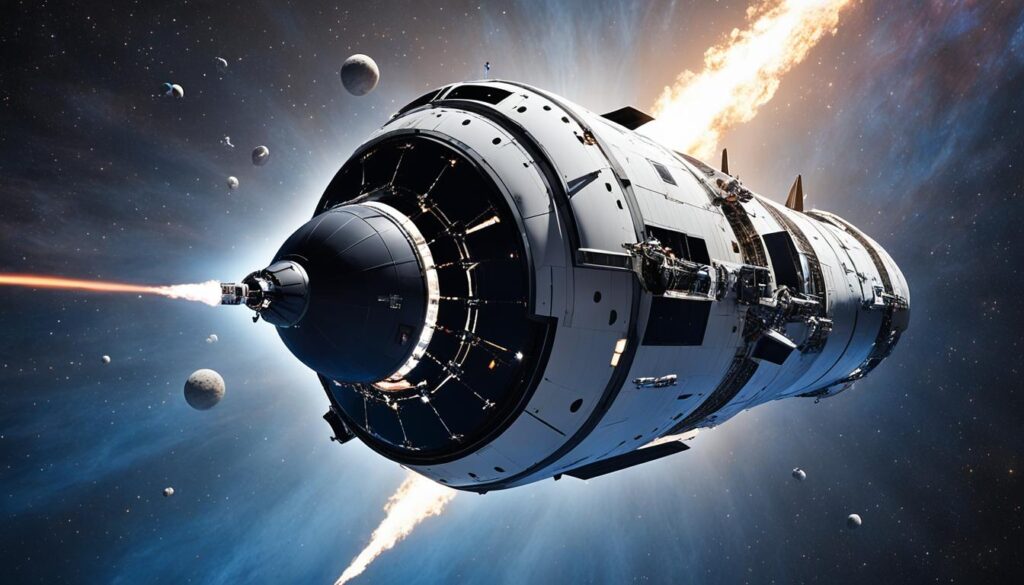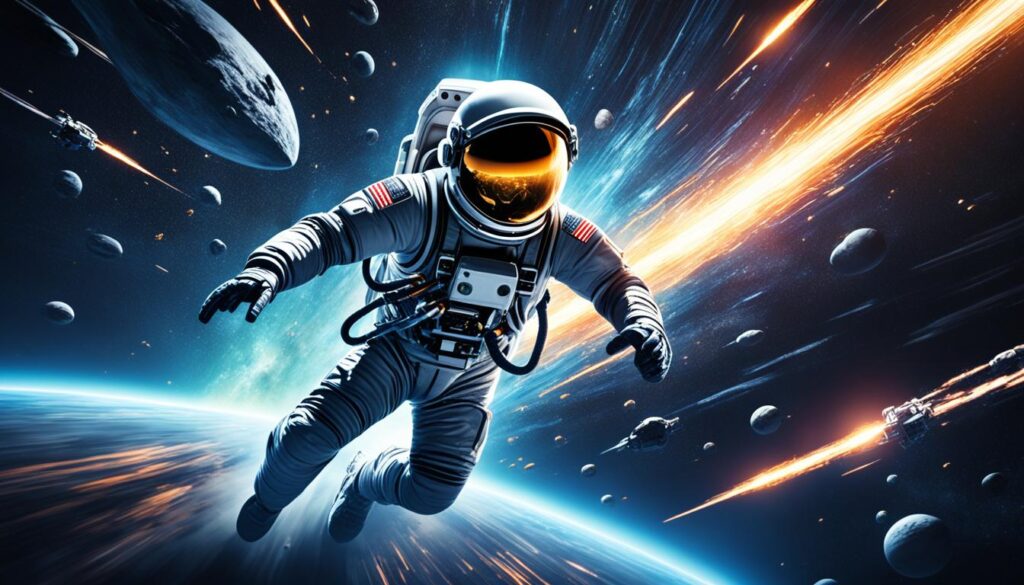“As an Amazon Associate I earn from qualifying purchases.” .
Ever wondered if we’ll break the speed limit of space travel? The speed of light has always seemed impossible to beat. But, our drive to explore further takes us closer to that limit. Interplanetary travel is an exciting plan. To make it real, we need to go even faster in space.
Key Takeaways
- The current human speed record was set by the Apollo 10 astronauts at 24,790 mph (39,897 km/h) relative to Earth.1
- NASA’s Orion spacecraft is designed to reach typical maximum velocities around 19,900 mph (32,000 km/h) for future missions.1
- Micrometeoroids, tiny space rocks, can reach devastating speeds of nearly 186,000 mph (300,000 km/h), posing potential hazards to spacecraft.1
- Advanced propulsion systems like fission, fusion, and antimatter-fueled engines could theoretically accelerate a vessel up to 10% of the speed of light, approximately 62,000,000 mph (100,000,000 km/h).1
- The speed of light, at 299,792.458 km/s, serves as the universal cosmic speed limit, according to the laws of physics.2
Introduction to Space Travel Speeds
People are always looking for ways to go faster. We break records in speed in many areas. This includes cars on tracks and jets in the sky. Our goal is to travel faster in space too. This would help us reach new parts of the universe quicker, with less risk. And it would let us take on bigger and better missions.
Humanity’s Obsession with Speed
Throughout history, we’ve wanted to be faster. This drive comes from wanting to surpass what we thought was our limit. We started with simple ways to travel and now have advanced machines. This is all to explore, learn, and grow as a society.
Current Human Speed Record: Apollo 10 Mission
The Apollo 10 mission in 1969 set a speed record we have yet to break. The NASA astronauts on this mission hit 24,790 mph going around Earth. This achievement proved we could go fast in space. And it made us dream of even quicker trips beyond the moon.
We look up and dream of what’s out there. This never-ending search for more speed in space keeps us going. It helps us test new limits and understand more about our universe everyone lives in.
| Mission | Top Speed | Year |
|---|---|---|
| Apollo 10 | 24,790 mph (39,897 km/h) | 1969 |
| New Horizons Probe | 36,373 mph (58,536 km/h)3 | 2006 |
| Voyager 1 | 38,610 mph (62,140 km/h)4 | 1977 |
The records achieved by NASA’s Apollo 10 mission and the Voyager 1 spacecraft showcase the remarkable strides humanity has made in conquering cosmic velocities and pushing the boundaries of human space travel4.
NASA’s Orion Spacecraft: Pushing Speed Boundaries
NASA’s Orion spacecraft aims to beat the old speed record from Apollo 10. It will take future space travel to new levels.
Designing Orion for Higher Velocities
Orion is built for various missions, like visiting Mars with a crew. It can reach about 19,900 mph in its normal operation, going even faster when needed.
The outer layer of the spacecraft is tough, protecting it from tiny space rocks. Important flight systems are placed carefully to keep them safe from harm, making Orion strong for high-speed travel.

The Artemis I mission launched on November 16, 2022, from Kennedy Space Center. This marked a big step forward in space travel speeds. Many companies worked together on the Orion spacecraft, including Boeing and Lockheed Martin.
| Mission Parameter | Artemis I |
|---|---|
| Distance Traveled | 1.3 million miles (2.1 million km)5 |
| Closest Lunar Approach | 130 km (80 mi)5 |
| Maximum Distance from Earth | 432,210 km (268,563 mi)5 |
| Duration | 25 days, 10 hours, 53 minutes5 |
Artemis I’s success opens doors for more NASA missions in the future. These new missions will make high-speed travel even better. They’ll let us explore space more efficiently and with fewer risks.
Challenges of High-Speed Space Travel
Going faster in space is a big goal for us. It could cut travel time and let us explore more. But, reaching higher speeds comes with its share of serious challenges. One big issue is how the human body deals with the pulls and stops from speeding up and slowing down.
Withstanding G-Forces
Rapid starts and stops can be deadly because of G-forces. These forces can push or pull you from top to bottom. This can make you see badly, pass out, or get hurt. While we can handle quick G-force hits, staying at high-speeds for a while needs special skills and gear. Studies show most people can deal with a push of about five Gs before passing out. Specially trained flyers might handle up to nine Gs. And astronauts have felt from three to eight Gs when they launch or land.1
Micrometeoroids and Protective Shielding
Another tough problem for fast space travel is micrometeoroids. These are tiny rocks flying super fast, up to 186,000mph (300,000km/h), and can hurt us in space.1 These tiny rocks are a big danger for fast ships because they’re so quick. NASA’s Orion ship has a really thick outer layer and special shields. They protect the crew and ship from these tiny but fast rocks.
| Hazard | Description | Mitigation |
|---|---|---|
| G-Forces | Accelerative forces that can cause vision impairment, loss of consciousness, and injuries | Specialized training, protective equipment |
| Micrometeoroids | Tiny space rocks traveling at incredibly high speeds, posing a threat to spacecraft | Protective outer layer, shielding, strategic equipment placement |
Aiming for high speeds in space travel sure is exciting. But, we must first solve how to keep our crews safe from G-forces and space rocks. This is vital for astronaut safety and ship survival on fast space journeys.
Revolutionizing Spacecraft Propulsion
Heading into space more, we need faster advanced propulsion systems. These are for future spacecraft to travel between planets. Scientists are looking at new ideas. These could break the limits of old-fashioned rockets.
Nuclear Fission and Fusion Propulsion
One exciting path is nuclear propulsion. Fission engines split atoms to make thrust. Fusion propulsion joins atoms together. These could make spacecraft go up to 10% the speed of light. That’s around 62,000,000 mph (100,000,000 km/h).6 Even though these methods are new, they follow old principles from the Atomic Age.
Antimatter-Fueled Engines
The idea of antimatter propulsion is very exciting. Antimatter is like a twin to normal matter. But when they meet, they explode, turning into pure energy. Making and keeping antimatter is hard. But antimatter-fueled engines could make spacecraft go fast over long times.
These new ways to move space vehicles promise to change future spacecraft engines a lot. They will help us travel faster across space. These are big steps in technology and understanding the universe. Flying through space might soon become much quicker and easier.
| Propulsion System | Theoretical Speed | Key Principle |
|---|---|---|
| Chemical Rockets | ~25,000 mph | Combustion of propellants |
| Nuclear Fission/Fusion | ~62,000,000 mph | Splitting/Combining atomic nuclei |
| Antimatter Annihilation | Substantial fraction of light speed | Matter-antimatter reactions |
We aim to learn great things about space. Making advanced propulsion systems is key. For future spacecraft to move fast across space. New advances in nuclear propulsion, fission engines, fusion propulsion, and antimatter propulsion push us closer to space’s limits. They open up new worlds for us to explore.
The Speed of Light: An Ultimate Limit?
According to Einstein’s theory of relativity, the speed of light is the top speed in the universe, reaching around 299,792,458 meters per second. That’s roughly 186,000 miles every second.7
Einstein’s Theory of Relativity
Einstein’s idea changed our view on space, time, and gravity. It showed physics are the same for everyone not speeding up, no matter where they are. Also, it proved that the light speed stays constant, no matter how fast the light moves.7 This means that the speed of light is the fastest anything can go in the universe. According to this idea, motions and how we see time and space change depending on how we’re moving. But, one thing stays the same: the speed of light.7
Massless Particles and the Speed of Light
Things without mass, like light particles called photons, are the only ones that can actually reach the speed of light.7 Material things with weight, even if we use a lot of energy, can’t reach this limit. This is because they get heavier and heavier as they get closer to the light speed.7 Even if a spaceship kept speeding up at 9.8 meters per second squared for almost a year, it would still be way slower than light.7

When objects get really close to light speed, strange things happen. Time can slow down for the moving object, and its length can actually get shorter.7 People on Earth would see a space traveler’s clock going slower than their own, for example. This is all because of the special way time and space work when things go very fast.7
There’s a chance that some type of matter could go faster than light, but this is still just a theory. In everything we know today about physics, light speed remains unbeatable.
Cosmic Distances and Travel Times
The vastness of the cosmos shows us giant interplanetary distances. This makes it key to find ways to travel through space faster.4 Light zips from Earth to the Moon in only 1.3 seconds.
A person walking non-stop takes over 9 years to make the same trip.
Reaching the Moon at Different Speeds
Speed makes a huge difference in space travel times. Light takes just 1.3 seconds to get to the Moon.4 Yet an electron beam takes 2.9 minutes.
The Space Shuttle would move for 14 hours. A jet needs 18 days. A New York City subway car, at its fastest, would travel for 220 days.
These examples show how traveling faster in space can change everything. It can make exploring space easier and safer.
Beyond our cosmic backyard, distances get even bigger.4 Voyager 1 is the farthest human-made object. It’s 163 times farther from Earth than the Sun. It travels at 17 km/s.
Proxima Centauri, the closest star system, is over 9,000 times more distant than Neptune. This shows how big the universe is. If we make the Earth-Sun distance one meter, the nearest star would be 276 kilometers away.
| Object | Distance from Earth | Travel Time (at 1 m/s) |
|---|---|---|
| Moon | 380,000 km | 9 years |
| Voyager 1 | 163 AU | 5,172 years |
| Proxima Centauri | 268,332 AU | 8,498,470 years |
Even though Voyager 1 is the fastest craft going out from Earth, it hasn’t gone far.4 After 46 years, it’s only traveled 1/390th of a light-year. Its speed compared to light is very slow, at 1/17,600 times less.
These facts show how hard and long it is to explore the stars with our current tech. We urgently need new ways to travel very fast in space.
Relativistic Effects at Near-Light Speeds
Objects nearing light speed show strange relativistic phenomena as explained by Einstein’s relativity. Time dilation and length contraction are two major effects.
Time Dilation
Time dilation means time slows down for fast-moving objects. This happens when they get close to the speed of light compared to something still. Time dilation effects are more obvious at faster speeds.
If a clock is on a speeding spacecraft, it appears to tick slower than a matching one on Earth. This illustrates how time stretches out in space.
At 0.99c (99% of light speed), someone in a spaceship sees time move slower by 7 times compared to others. This makes long trips feel shorter to the traveler8. It hints at how future space journeys could seem quicker to those on board.
Length Contraction
Length contraction is the shrinking of an object when it moves fast. A spacecraft, for example, looks compressed to an Earth viewer at high speeds. But its crew doesn’t notice any change.
Moving towards Orion at up to 0.99c changes how we see space. Things get squeezed and might look and shine differently due to speed-related effects8. This includes changes in color and brightness of stars.
At 0.9999999999999994c, nearly all the light from the universe shifts way beyond what we could see. Almost no light appears in its usual state8. At 0.99c, the effect is less but still astonishing, with most light seeming to come from in front of us8.
Future Prospects for Faster Space Exploration
We’re aiming to travel faster between planets and stars. To do so, we’re looking into new ways to propel spacecraft. Conventional rockets can only go so fast. But the idea of traveling faster than light is very exciting. It’s a challenge that goes beyond what we know about physics.
Warp Drive and Exotic Propulsion Concepts
The warp drive theory imagines a way to bend space and time. This would allow a ship to travel huge distances quickly. Invented in science fiction, warp drives work by warping space. This means the ship can move faster than the speed of light. It’s a fanciful yet intriguing idea about future space travel.9
Even though the warp drive sounds like fiction, it’s a hot topic in science. Its first concept, by Miguel Alcubierre in 1994, needed a type of rare matter. This material doesn’t exist, making such travel very hard. But lately, we’re finding ways to make warp drives work without this impossible material.
As we explore the cosmos, our insatiable curiosity drives us to push the boundaries of what’s possible, inspiring unconventional ideas that could redefine the very nature of space travel.
We might not reach the speeds for faster-than-light travel anytime soon. However, the search for advanced propulsion methods is exciting. It keeps us dreaming and leading to new discoveries about the universe.
Conclusion
The drive to explore the cosmos faster comes from our strong desire to move through space more quickly. It’s all about wanting to get there faster, safer, and with less effort. Right now, our methods have limits set by what we can do with technology. Still, new ideas for engines, such as those using nuclear power or antimatter, might change this. They could make spacecraft travel faster than we ever believed possible4.
But, getting beyond the speed of light would need major changes in how we understand physics. The idea of a “warp drive” is very interesting to some scientists. It could lead to new technologies that let us travel faster than we ever thought was possible. Who knows, we might find a way to travel across the universe in a blink of an eye10.
Even if it seems very hard, human curiosity and drive to explore space are strong. We want to beat the speeds we know today. Every step we take in improving our engines and learning more about space gets us closer to yet unimagined journeys. These could change how we view the universe and our role in it forever.
FAQ
What is the current record for the fastest human space travel?
What is NASA’s Orion spacecraft designed for?
What are the challenges of high-speed space travel?
How can future spacecraft achieve significantly faster travel speeds?
What is the ultimate cosmic speed limit according to Einstein’s theory of relativity?
How does speed affect cosmic travel times?
What are the relativistic effects experienced at near-light speeds?
What is the “warp drive” concept?
Source Links
- https://www.bbc.com/future/article/20150809-how-fast-could-humans-travel-safely-through-space
- https://www.skyatnightmagazine.com/space-science/fastest-things-in-universe
- https://airandspace.si.edu/explore/stories/speed
- https://en.wikipedia.org/wiki/Interstellar_travel
- https://en.wikipedia.org/wiki/Artemis_1
- https://www.popularmechanics.com/science/a60941082/light-speed-warp-drive-breakthrough/
- https://bigthink.com/starts-with-a-bang/alien-space-travel-speed-of-light/
- https://math.ucr.edu/home/baez/physics/Relativity/SR/Spaceship/spaceship.html
- https://theconversation.com/warp-drives-physicists-give-chances-of-faster-than-light-space-travel-a-boost-157391
- https://www.nasa.gov/solar-system/three-ways-to-travel-at-nearly-the-speed-of-light/
“As an Amazon Associate I earn from qualifying purchases.” .



